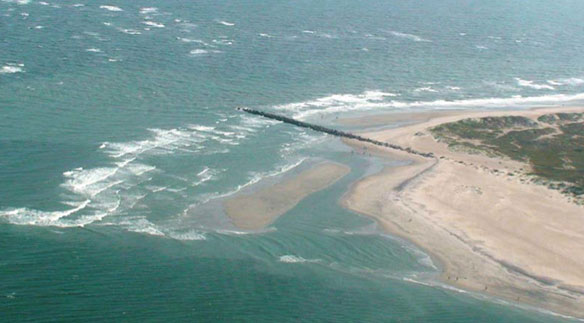Photo source: PSDS.
“Terminal groins are shore-perpendicular structures built in attempt to slow erosion. When a groin works as intended, sand moving along the beach in the so-called downdrift direction is trapped on the updrift side of the groin, causing a sand deficit and increasing erosion rates on the downdrift side. This well-documented and unquestioned impact is widely cited in the engineering and geologic literature.” —Rob Young, Director of the Program for the Study of Developed Shorelines (PSDS) at Western Carolina University
Holden Beach commissioners are withdrawing the town’s permit application to build a terminal groin at the east end of the barrier island.
Terminal groins are wall-like structures built perpendicular to the shore at inlets to contain sand in areas of high erosion, like that of beaches at inlets…
Also of Interest:
Terminal Groins Don’t Stop Erosion; Coastal Review (05-03-2016)
The Negative Impacts Of Groins, (02-12-2009)
The negative impact of groins on downdrift shorelines is well understood. When a groin works as intended, sand moving along the beach in the so-called downdrift direction is trapped on the updrift side of the groin, causing a sand deficit and increasing erosion rates on the downdrift side. This well-documented and unquestioned impact is widely cited in the engineering and geologic literature.
A Fiscal Analysis of Shifting Inlets and Terminal Groins in North Carolina, By Rob Young Director of the Program for the Study of Developed Shorelines at Western Carolina University (01-28-2011)
The debate about terminal groins, shore-perpendicular structures built at inlets in attempt to slow erosion, is worth keeping an eye on, whether you live in western North Carolina or in a coastal community, because it could cost you and our state a pretty penny…
Living Shorelines: Better Than Bulkheads, Coastal Review Online (02-08-2016)
More than 14,000 miles – 14 percent of continental U.S. coastline — has been armored with hardened structures. Hardened structures cause elevated rates of erosion on the shoreward side of the structure…
“Engineering away our natural defenses: An analysis of shoreline hardening in the US,” A Study by By Rachel K. Pittman, ResearchGate (08-08-2015)
Rapid coastal population growth and development are primary drivers of marine habitat degradation. Although shoreline hardening, a byproduct of development, can accelerate erosion and loss of beaches and tidal wetlands, it is a common practice globally. 22,842 km of continental U.S. shoreline, 14% of the total, has been hardened…
Coastal erosion needs our attention, South Coast Today (01-04-2016)
Rethinking Living Shorelines, By Orrin H. Pilkey, Rob Young, Norma Longo, and Andy Coburn;Program for the Study of Developed Shorelines / Western Carolina University, March 1, 2012, Nicholas School of the Environment, Duke University
In response to the detrimental environmental impacts caused by traditional erosion control structures, environmental groups, state and federal resource management agencies, now advocate an approach known as “Living Shorelines”that embraces the use of natural habitat elements such as indigenous vegetation, to stabilize and protect eroding shorelines.
“North Carolina: The Beaches Are Moving,” A Video featuring Orrin Pilkey, PhD
World famous coastal geologist Orrin H. Pilkey takes us to the beach and explains why erosion has become a problem…









